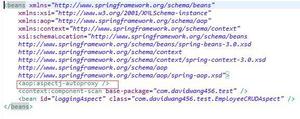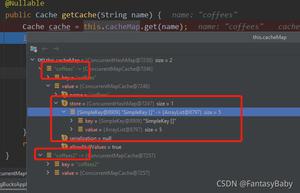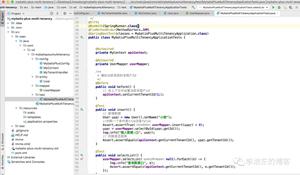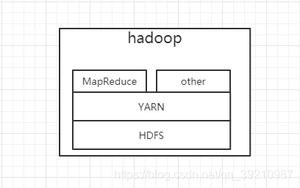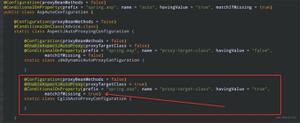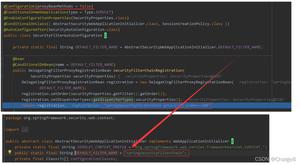Spring框架(5)---AspectJ实现AOP
本文内容纲要:Spring框架(5)---AspectJ实现AOP
AspectJ实现AOP
上一篇文章Spring框架(4)---AOP讲解铺垫,讲了一些基础AOP理解性的东西,那么这篇文章真正开始讲解AOP
通过AspectJ实现AOP要比普通的实现Aop要方便的多,所以第五篇文章有关SpringAOP我暂且不写,后面整理好了再补充上;
那我们首先还是讲一些有的没的的东西:
什么是Spring的AspectJ的AOP
AspectJ是一个面向切面的框架,它扩展了Java语言。AspectJ定义了AOP语法所以它有一个专门的编译器用来生成遵守Java字节编码规范的Class文件。
Spring2.0以后新增了对AspectJ切点表达式支持,@AspectJ 是AspectJ1.5新增功能,通过JDK5注解技术,允许直接在Bean类中定义切面
新版本Spring框架,建议使用AspectJ方式来开发AOP
那我们先来一个小案例,还是以前面狗的案例举例:
1.导入相关架包
在原来的基础上导入下面四个架包:
- spring-aop-4.2.0.RELEASE.jar
- com.springsource.org.aopalliance-1.0.0.jar
- spring-aspects-4.2.0.RELEASE.jar
- com.springsource.org.aspectj.weaver-1.6.8.RELEASE.jar
2.编写配置文件applicationContext.xml 导入aop的命名空间
<?xml version="1.0" encoding="UTF-8"?><beans xmlns="http://www.springframework.org/schema/beans"
xmlns:xsi="http://www.w3.org/2001/XMLSchema-instance"
xmlns:p="http://www.springframework.org/schema/p"
xmlns:aop="http://www.springframework.org/schema/aop"
xmlns:context="http://www.springframework.org/schema/context" xsi:schemaLocation="
http://www.springframework.org/schema/beans http://www.springframework.org/schema/beans/spring-beans.xsd
http://www.springframework.org/schema/context http://www.springframework.org/schema/context/spring-context.xsd
http://www.springframework.org/schema/aop http://www.springframework.org/schema/aop/spring-aop.xsd"> <!-- bean definitions here -->
<!-- 配置注解bean所在的包 -->
<context:annotation-config/>
<context:component-scan base-package="com.study.spring.d_advisor"></context:component-scan>
<!-- 打开自动代理 -->
<aop:aspectj-autoproxy/>
</beans>
3.编写代理对象
1 public class Dog { 2
3 public void run() {
4 System.out.println("狗会跑");
5 }
6
7 public void jump() {
8
9 System.out.println("狗会跳");
10
11 }
12
13 public void eat() {
14
15 System.out.println("狗能吃");
16 }
17 }
4)编写切面类
import org.aspectj.lang.annotation.Aspect;import org.aspectj.lang.annotation.Before;
//@Aspect声明当前类是一个切面
@Aspect
public class MyAspectJ {
//@Before代表在执行方法之前执行增强代码
@Before("execution(* com.study.dog.Dog.*(..))")
public void before1() {
System.out.println("饲养员叫你你猜能动");
}
}
5编写配置文件
<?xml version="1.0" encoding="UTF-8"?><beans xmlns="http://www.springframework.org/schema/beans"
xmlns:xsi="http://www.w3.org/2001/XMLSchema-instance"
xmlns:p="http://www.springframework.org/schema/p"
xmlns:aop="http://www.springframework.org/schema/aop"
xmlns:context="http://www.springframework.org/schema/context" xsi:schemaLocation="
http://www.springframework.org/schema/beans http://www.springframework.org/schema/beans/spring-beans.xsd
http://www.springframework.org/schema/context http://www.springframework.org/schema/context/spring-context.xsd
http://www.springframework.org/schema/aop http://www.springframework.org/schema/aop/spring-aop.xsd"> <!-- bean definitions here -->
<!-- 配置注解bean所在的包 -->
<context:annotation-config/>
<context:component-scan base-package="com.study.spring.d_advisor"></context:component-scan>
<!-- 打开自动代理 -->
<aop:aspectj-autoproxy/>
<!-- 被代理对象 -->
<bean id="Dog" class="com.study.dog.Dog"></bean>
<!-- 切面 -->
<bean id="MyAspectJ" class="com.study.dog.MyAspectJ"></bean>
</beans>
6.编写测试类
1 import org.junit.Test; 2 import org.junit.runner.RunWith;
3 import org.springframework.beans.factory.annotation.Autowired;
4 import org.springframework.beans.factory.annotation.Qualifier;
5 import org.springframework.test.context.ContextConfiguration;
6 import org.springframework.test.context.junit4.SpringJUnit4ClassRunner;
7
8 //完成配置文件的加载
9 @RunWith(SpringJUnit4ClassRunner.class)
10 @ContextConfiguration(locations="classpath:applicationContext.xml")
11 public class AspectJTest {
12 // 得到dog对象
13 @Autowired
14 @Qualifier("Dog")
15 private Dog dog;
16
17 @Test
18 public void Demo1() {
19 dog.eat();
20 dog.run();
21 dog.jump();
22 }
23 /*
24 * 输出结果:
25 * 饲养员叫你你猜能动
26 * 狗能吃
27 * 饲养员叫你你猜能动
28 * 狗会跑
29 * 饲养员叫你你猜能动
30 * 狗会跳
31 */
32 }
总结:上面是一个最简单的AspectJ的AOP,我们这样就可以通过输入一个”饲养员叫你你猜能动",就可以在多个方法中存在,在以后开发非常需要
那么下来来说一些非常重要的干货!
** AspectJ表达式:**
** 语法:execution(表达式)** 通过execution函数,可以定义切点的方法切入
** execution(<访问修饰符>?<返回类型><方法名>(<参数>)<异常>)**** **
例如
execution(public * *(..)) 匹配所有类public方法
execution(* cn.study.dao..*(..)) 匹配指定包下所有类方法,不包含子包
execution(* cn.study.dao..*(..)) ..*表示包、子孙包下所有类
execution(* cn.study.service.UserService.*(..)) 匹配指定类所有方法
execution(* cn.study.dao.GenericDAO+.*(..)) 匹配实现特定接口所有类方法
execution(* save*(..)) 匹配所有save开头的方法
** AspectJ增强**
** **@Before 前置通知,相当于BeforeAdvice
@AfterReturning 后置通知,相当于AfterReturningAdvice
@Around 环绕通知,相当于MethodInterceptor
@AfterThrowing抛出通知,相当于ThrowAdvice
@After 最终final通知,不管是否异常,该通知都会执行
@DeclareParents 引介通知,相当于IntroductionInterceptor (不要求掌握)
那现在我们通过上面的列子,来全面贯彻上面的干货!
对上面MyAspectJ的进行全面增强:
import org.aspectj.lang.JoinPoint;import org.aspectj.lang.ProceedingJoinPoint;
import org.aspectj.lang.annotation.After;
import org.aspectj.lang.annotation.AfterReturning;
import org.aspectj.lang.annotation.AfterThrowing;
import org.aspectj.lang.annotation.Around;
import org.aspectj.lang.annotation.Aspect;
import org.aspectj.lang.annotation.Before;
import org.aspectj.lang.annotation.Pointcut;
//@Aspect声明当前类是一个切面
@Aspect
public class MyAspectJ {
//@Before代表在执行方法之前执行增强代码
@Before("execution(* com.study.dog.Dog.run(..))")
public void before(JoinPoint joinPoint){
System.out.println("前置增强...."+joinPoint);
}
//后置通知
@AfterReturning (value="execution(* com.study.dog.Dog.jump(..))",returning="returnVal")
public void afterReturin(Object returnVal){
System.out.println("后置增强....方法的返回值:"+returnVal);
}
//环绕通知
@Around(value="MyAspectJ.myPointcut()")
public Object around(ProceedingJoinPoint proceedingJoinPoint) throws Throwable{
System.out.println("环绕前增强....");
Object obj = proceedingJoinPoint.proceed();
System.out.println("环绕后增强....");
return obj;
}
//抛出通知
@AfterThrowing(value="MyAspectJ.myPointcut()",throwing="e")
public void afterThrowing(Throwable e){
System.out.println("不好了 出异常了!!!"+e.getMessage());
}
//最终final通知,不管是否异常,该通知都会执行
@After("MyAspectJ.myPointcut()")
public void after(){
System.out.println("最终通知...");
}
//切点的定义
@Pointcut("execution(* com.study.dog.Dog.eat(..))")
private void myPointcut(){}
}
编写测试类AspectJTest 和上面一点不变
import org.junit.Test;import org.junit.runner.RunWith;
import org.springframework.beans.factory.annotation.Autowired;
import org.springframework.beans.factory.annotation.Qualifier;
import org.springframework.test.context.ContextConfiguration;
import org.springframework.test.context.junit4.SpringJUnit4ClassRunner;
//完成配置文件的加载
@RunWith(SpringJUnit4ClassRunner.class)
@ContextConfiguration(locations="classpath:applicationContext.xml")
public class AspectJTest {
// 得到dog对象
@Autowired
@Qualifier("Dog")
private Dog dog;
@Test
public void Demo1() {
dog.eat();
dog.run();
dog.jump();
}
}
运行结果:
通过这个例子,相信大家对于AspectJ的AOP有了一定的了解了。
最后补充一个面试题:
Advisor和Aspect的区别?
** ** Advisor:Spring传统意义上的切面:支持一个切点和一个通知的组合.
Aspect:可以支持多个切点和多个通知的组合.
这篇文章就讲到这里,有不足之处,欢迎大家指出,谢谢!
本文内容总结:Spring框架(5)---AspectJ实现AOP
原文链接:https://www.cnblogs.com/qdhxhz/p/6516946.html
以上是 Spring框架(5)---AspectJ实现AOP 的全部内容, 来源链接: utcz.com/z/362648.html

